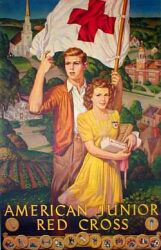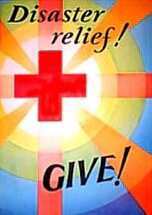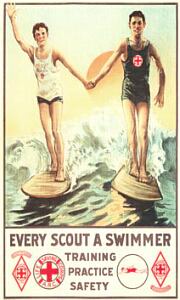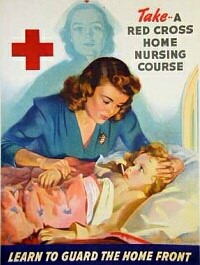Domestic Services
.
American Junior Red Cross
.
Eighteen million members in public, private,
and parochial schools engaged in a program of activities planned to develop
social consciousness and international understanding.
.
 |
. |
Activities of the Junior Red Cross included
classes in first aid, home nursing, accident prevention, swimming, lifesaving,
nutrition, canteen, and staff assistance; junior first-aid detachments,
disaster relief corps, bicycle corps, victory gardens; and a Nation-wide
salvage program. Members made recreational and comfort articles for servicemen,
produced garments for war victims, contributed to child war relief through
the National Children's Fund, and filled gift boxes for children overseas.
They also participated in international and
countrywide programs of school correspondence. Local service projects designed
to meet community needs were also part of the program. |
.
Blood Donor Service
.
| At the request of the Surgeons General of
the Army and Navy, the American Red Cross collected volunteer blood donations
to be processed into dried plasma and to be flown overseas for whole blood
transfusions. Blood donor centers were operated in 31 cities by 1945, where
blood was collected and shipped to laboratories for processing or flown
overseas.
Mobile units also visited nearby towns. Dried
plasma made it possible for Army and Navy doctors to provide emergency
transfusions on the scene of battle. The substances derived from the blood
collected by the Red Cross saved the lives of many soldiers and sailors. |
. |
 |
Civilian War Aid
.
An agreement jointly signed by the American Red
Cross and the Office of Defense Health and Welfare Services charged Red
Cross chapters with the responsibility of providing "food, clothing, and
temporary shelter" during the period of emergency following enemy action.
Under an agreement between the American Red Cross and the Office of Civilian
Defense, the personnel and services furnished by the Red Cross operated
in conjunction with the Emergency Medical Service to meet needs arising
from expected or actual injuries to civilians through enemy action.
 |
. |
The Red Cross recruited and trained volunteer
nurse's aides; trained people in first aid; provided dressings, bandages,
and supplementary equipment, after consultation with the Chief of the Emergency
Medical Service; equipped and operated emergency ambulances; and provided
supplementary transportation for the walking injured and Emergency Medical
Service personnel. |
.
Disaster Relief
.
| As the disaster relief agency of the Nation
and the community, the Red Cross was responsible for direction and coordination
of disaster preparedness and relief measures. The Red Cross provided emergency
relief and rehabilitation aid for families and individuals suffering from
the effects of natural disasters, aided in rescue work, sheltered the homeless
and supplemented available medical and hospital care. Rehabilitation was
on the basis of need and included medical and nursing aid; rebuilding or
repairing homes; replacing furniture and household goods, farm supplies,
livestock, and equipment; and furnishing occupational training equipment
and supplies. Red Cross responsibility in natural disasters remained the
same in war as in peace. |
. |
 |
.
First Aid, Water Safety, and
Accident Prevention
.
 |
. |
Red Cross first-aid training provided for
the emergency care of injured persons in the absence of immediate medical
attention.
Water-safety training taught skills and procedures
essential to security in and about the water, and for the rescue of those
in danger of drowning. Functional swimming and water safety was a special
course for the training of persons in the armed forces and for those approaching
military age in the type of aquatic skill most useful in warfare.
Accident prevention courses taught by the Red
Cross emphasized the problems caused by common accidents that occurred
in homes and on farms, as well as those which occurred in the day-by-day
activities of boys and girls. |
.
Personnel were trained in the emergency care
of the victims of highway accidents and highway first-aid stations were
designated throughout the Nation; drivers of trucks, automobiles, and the
like, were similarly trained, and their equipment designated as mobile
first-aid units. Red Cross first-aid detachments were organized in mills,
factories, department stores, apartment houses, schools, and other places
where many persons were drawn together and where the hazard of exposure
to mass accidents might be high. Close cooperation was maintained
with governmental departments and agencies in the training of their personnel
through the courses offered by the Red Cross. At the request of those in
authority, the same service was provided extensively to the armed forces.
.
Nutrition
.
The program of the Red Cross Nutrition Service
was an educational program designed to accomplish the following goals:
(1) disseminate sound nutrition information and give helpful aids in applying
it to varying food and socio-economic situations; (2) train Red Cross nutrition
aides to assist in the Red Cross chapter nutrition program and in other
community nutrition activities; (3) train Red Cross volunteer canteen workers
to assist in emergency mass feeding necessitated by a natural disaster
or enemy action, and in community projects such as school lunches and day
care centers; (4) train in mass feeding groups such as food service staffs
of schools and other lunchrooms or cafeterias, boarding houses, child-caring
institutions, and homes for the aged; (5) train Red Cross volunteer dietitian's
aides to assist in hospital dietary departments. The Red Cross nutrition
program was coordinated with the Government's national nutrition program.
.
Nursing Service
.
| The Red Cross recruited and maintained not
only a reserve of qualified nurses for the Army and the Navy for service
in time of war, but also a reserve for routine Red Cross duties, including
disaster relief. It also conducted a program in public health nursing and
instruction in home nursing for laywomen.
This course was based on the textbook, Red
Cross Home Nursing, which taught the principles of personal, home, and
community health, and the procedures necessary in caring for the sick at
home. It had special value during World War II, when doctors and nurses
were needed for military service, and the homemaker had to depend largely
on her own resources. |
. |
 |
|
